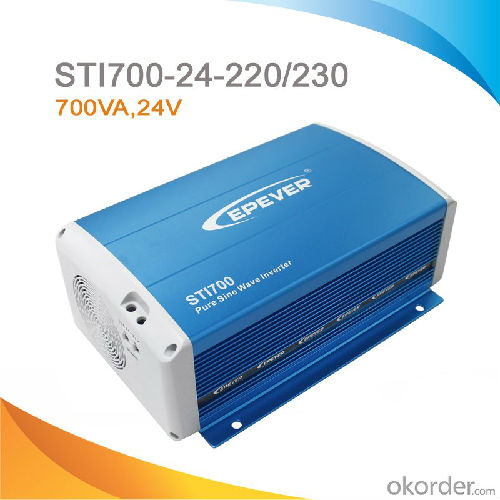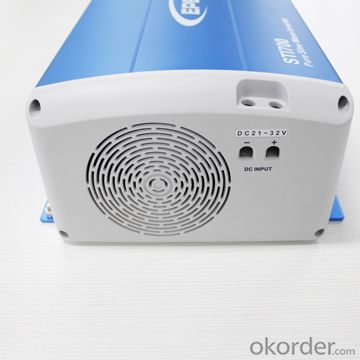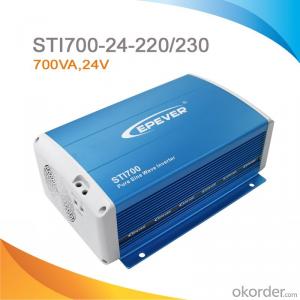High Efficiency Off-Grid Pure Sine Wave Power Inverter 700W, 24V-220V/230V,STI700
- Loading Port:
- China Main Port
- Payment Terms:
- TT or LC
- Min Order Qty:
- -
- Supply Capability:
- -
OKorder Service Pledge
OKorder Financial Service
You Might Also Like
Description
STI series is a sine wave power frequency inverter which can convert 12V or 24V DC to 220VAC or 230VAC 50Hz based on full digital and intelligent design. The inverter can be applied in many fields especially for solar photovoltaic power system.


Features:
·Complete isolation-type inverter technology, noiseless output
·Adoption of advanced SPWM technology, pure sine wave output
·Dynamic current loop control technology to ensure inverter reliable operation.
·Wide DC input voltage range
·Excellent EMC design
·Low output harmonic distortion(THD≤3%)
·LED indicators display input voltage range, load power range, normal output & failure state
·Optional energy saving mode
·Wide working temperature range (industrial level)
·Continuous operation at full power
Protections:
·Output Short Circuit protection
·Overload protection
·Input reverse polarity protection
·Input low voltage protection
·Input over voltage protection
·Inverter abnormal protection
·Overheating protection


Specification:
Types | SHI600-12 | SHI600-22 |
Nominal Battery Voltage | 12V | 24V |
Input Voltage Range | 10.8~16Vdc | 21.6~32Vdc |
No Load Current | ≤0.7A | ≤0.45A |
Output Wave | Pure Sine Wave | |
Output Voltage | 220Vac±3% / 230Vac±10% | |
Continuous Power | 600W | |
Power 10 sec | 900W | |
Power 1.5 sec | 1200W | |
Surge Power | 1350W | |
Frequency | 50/60Hz±0.2% | |
Distortion THD | ≤ 3% (resistive load) | |
Efficiency at Rated Power | ≥91% | ≥92% |
Max. Efficiency | ≥93% | ≥94% |
Terminal | 25mm2 | |
Dimensions | 295×186×82mm | |
Installation | 150×178mm | |
Hole Size | Φ6mm | |
Net Weight | 2.3kg | |
Working Temperature | -20℃~ +50℃ | |
Storage Temperature | -35℃~ +70℃ | |
Humidity | < 95% (N.C.) | |
Altitude | < 5000m(Derating to operate according to IEC62040 at a height exceeding 1000m) | |
Insulation Resistance | Between DC input terminals and metal case: ≥550MΩ; Between AC output terminals and metal case: ≥550MΩ. | |
FAQ
Off Grid VS On Grid Panels, what's the difference?
The differences between both panels are related to the system where they are going to be installed.
On-grid installations, as the name said, are thought to feed the produced energy into the grid and for that it is important to have the biggest voltage that it is allowed (1000VDC in Europe, 600 VDC in USA). For a defined power, more voltage means less current (P=V*I) and less losses.
In off-grid installations it is different because you must storage the energy into batteries. Batteries usually work at 12, 24 or 48 VDC and off-grid photovoltaic modules work at the maximum power point (mpp) near this voltage (see the datasheets). So the controller that charges the batteries works also near the batteries voltage.
Your limiting factor here is going to be this controller. You have to see what is the maximum voltage and the maximum current that it can work with, upstream (photovoltaic modules) and downstream (batteries andinverter). Then you have to dimension your PV array (Voltage and Current).
Does inverter long warranty mean high quality?
SMA did bump up the warranty to 10 years when CSI demanded all inverter manufacturers to do so. The European Sunny Boys are only warrantied for 5 years.
iPhones only have a one year warranty. Does that mean Apple products aren't reliable? Enphase offers a 25 year warranty on theiribut only one year on their inverters monitoring. Does this mean their monitoring is not as reliable as their inverter? Of course not.
Offering long warranties have very real costs, especially for publicly traded companies like SMA. If we were to offer a 25 year warranty, we would have to hold a higher reserve on our balance sheet, making our products more expensive. We think that our customers would rather have our high quality products at a lower cost.
Start-ups invariably offer long warranties to make up for lack of track record or the perception of quality problems. As the unfortunate recent events at Solyndra have shown, long warranties offered by start-ups can have limited practical value.
Analogies can be drawn to the wind industry: in the early days, customers requested very long warranties (20 years or so), since it was the wild west and no one had a clue about long term O&M requirements for these big new turbines. Now that the wind industry has matured, turbine warranties are again very short (2 years is typical) since the large suppliers have a track record of shipping quality product that does not fail when properly maintained. You could say that PV today is like the wild west environment in wind 10 years ago.
- Q:Can a solar inverter be used with a solar-powered water pump?
- Yes, a solar inverter can be used with a solar-powered water pump. The solar inverter is responsible for converting the direct current (DC) power generated by the solar panels into alternating current (AC) power that can be used to operate the water pump. This allows for a more efficient and reliable operation of the solar-powered water pump system.
- Q:How do you calculate the efficiency loss due to temperature for a solar inverter?
- To calculate the efficiency loss due to temperature for a solar inverter, you need to determine the temperature coefficient of the inverter. This coefficient represents the rate at which the inverter's efficiency decreases with an increase in temperature. Once you have the temperature coefficient, you can calculate the efficiency loss by multiplying it with the difference between the actual operating temperature and the reference temperature. The reference temperature is typically the standard test condition temperature, which is usually around 25 degrees Celsius. The formula to calculate the efficiency loss is as follows: Efficiency Loss = Temperature Coefficient × (Operating Temperature - Reference Temperature) By plugging in the appropriate values, you can determine the efficiency loss due to temperature for a solar inverter.
- Q:Does a solar inverter require a separate grounding system?
- Typically, a solar inverter requires its own grounding system. This is because the solar panels produce DC electricity, which needs to be converted to AC electricity by the inverter. The AC electricity is then either sent to the electrical grid or used within the building. Grounding is crucial for safety and proper functioning. In a solar power system, the grounding system provides a safe path for electrical current in case of faults like short circuits or lightning strikes. To prevent electrical shock hazards and comply with safety standards, a separate grounding system for the solar inverter is necessary. It safeguards the equipment, the building, and the people using or working on the system. The specific grounding requirements for a solar inverter may vary depending on local electrical codes and regulations. It is important to seek guidance from a qualified electrician or solar installer to ensure that the grounding system is designed and installed correctly for optimal safety and performance.
- Q:Can a solar inverter be easily integrated into an existing electrical system?
- Yes, a solar inverter can be easily integrated into an existing electrical system. Solar inverters are designed to seamlessly connect with the existing electrical infrastructure of a building or property. They can be installed alongside the main electrical panel and connected to the grid, allowing the solar energy generated by the panels to be converted into usable electricity for the building's consumption. With the help of a qualified electrician or solar installer, the integration process can be straightforward and efficient.
- Q:Can a solar inverter be used in systems with multiple solar arrays?
- Yes, a solar inverter can be used in systems with multiple solar arrays. The inverter has the capability to convert the DC power generated by each solar array into AC power that can be used in the electrical system. It can manage and optimize the power output from multiple arrays, ensuring efficient and reliable operation of the overall solar system.
- Q:Can a solar inverter be used with different types of power control devices?
- Yes, a solar inverter can be used with different types of power control devices. Solar inverters are designed to convert the direct current (DC) generated by solar panels into alternating current (AC) that can be used to power household appliances and other electrical devices. They can be integrated with various power control devices such as charge controllers, battery banks, and grid-tie systems to optimize the energy output and manage the flow of electricity efficiently.
- Q:How does a solar inverter handle variations in solar panel tilt and orientation?
- A solar inverter handles variations in solar panel tilt and orientation by continuously monitoring the output voltage and current of the solar panels. It then adjusts the power conversion process to optimize the efficiency of power generation based on the tilt and orientation of the panels. This ensures that maximum power is extracted from the solar panels regardless of their position, allowing for optimal energy production.
- Q:What are the key factors affecting the reliability of a solar inverter?
- The key factors affecting the reliability of a solar inverter include the quality of components used, design and manufacturing processes, environmental conditions, maintenance practices, and the level of protection against electrical faults.
- Q:Can a solar inverter be used with solar concentrators?
- Yes, a solar inverter can be used with solar concentrators. Solar concentrators are designed to focus sunlight onto a smaller area, increasing its intensity. The concentrated sunlight is then converted into electricity by the solar panels and fed into the solar inverter, which converts the DC power generated by the panels into AC power suitable for use in homes or businesses. Therefore, solar concentrators and solar inverters can work together to maximize the efficiency and output of a solar energy system.
- Q:How do you calculate the maximum power point voltage for a solar inverter?
- To calculate the maximum power point voltage for a solar inverter, you need to determine the voltage at which the solar panels produce the maximum power output. This can be done by following the voltage-current (V-I) curve of the solar panels. By measuring the voltage and current at different points on the curve, you can identify the point where the product of voltage and current is the highest, indicating the maximum power point voltage.
1. Manufacturer Overview |
|
|---|---|
| Location | |
| Year Established | |
| Annual Output Value | |
| Main Markets | |
| Company Certifications | |
2. Manufacturer Certificates |
|
|---|---|
| a) Certification Name | |
| Range | |
| Reference | |
| Validity Period | |
3. Manufacturer Capability |
|
|---|---|
| a)Trade Capacity | |
| Nearest Port | |
| Export Percentage | |
| No.of Employees in Trade Department | |
| Language Spoken: | |
| b)Factory Information | |
| Factory Size: | |
| No. of Production Lines | |
| Contract Manufacturing | |
| Product Price Range | |
Send your message to us
High Efficiency Off-Grid Pure Sine Wave Power Inverter 700W, 24V-220V/230V,STI700
- Loading Port:
- China Main Port
- Payment Terms:
- TT or LC
- Min Order Qty:
- -
- Supply Capability:
- -
OKorder Service Pledge
OKorder Financial Service
Similar products
New products
Hot products
Hot Searches
Related keywords































